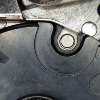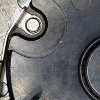RESOLVED!!!!!
All I had to do was reset the zero on my caliper and they all measure great! J/K...
Kind of resolved anyway. I kept going back to the shellplate torque as many of you said. And I'd tighten it, bind it up, loosen it, repeat over & over. Then was thinking about the drag line between the ball cuts for detent and some wear marks at the edge only between a few shell cutouts on underside....."
How can I get more torque if that is the problem?" I kept dwelling on that because only thing that made sense and I could see a correlation of loosening it and even higher primers. But nothing I did fixed it....adding the phenolic ball and reduced power spring, adding the needle bearing, but nothing would allow me to tighten it more- literally even the tiniest amount of additional clockwise movement would bind up the press.
So while cleaning it and tinkering again, I figured I'd try putting a dab of grease on the index pawl and wipe a real light coat on the underside of shellplate (this is with the factory parts in - not the upgrades). Even though the lubrication video or nothing I could find said to lube anything in that area, what could it hurt? Worked great and I could tighten the shellplate bolt more and not bind the machine. So did same process and tightened until I did bind it, then back off just a hair. Not only did the press run exceptionally well for 200 rds without all the random stoppages, it seated the primers very well. .003" depth was worst, most were .006", and some went to .009".
So either you are supposed to grease under the shellplate and I just totally missed that all this time, or something is still wrong, but the little bit of grease is a workaround for now.


Still all sorts of mixed headstamps, military brass, commercial brass, all 3 of my SRM primer brands - it just works now. And I don't feel nearly as bad about all those 7 y/o girls winning arm wrestling matches any longer.....




















